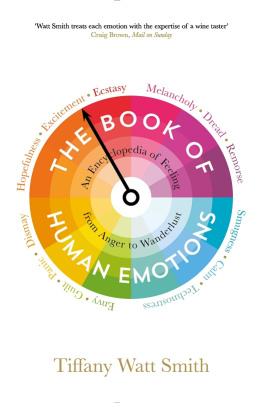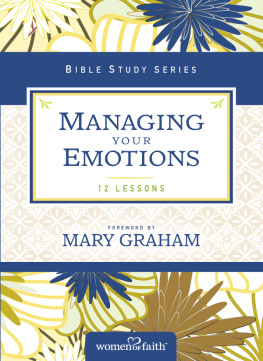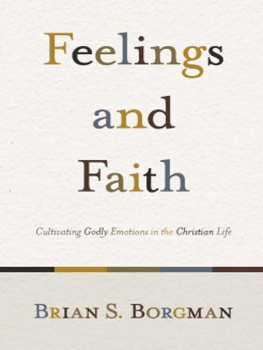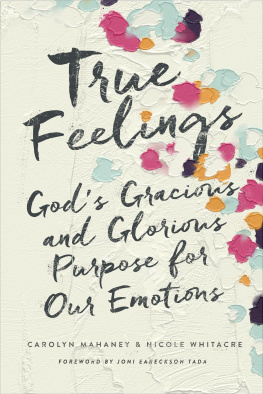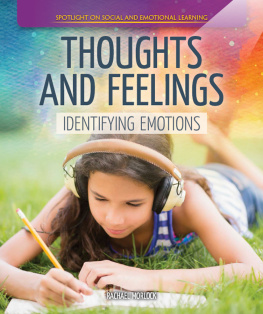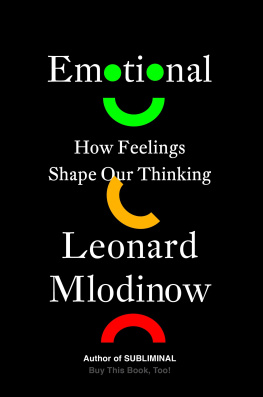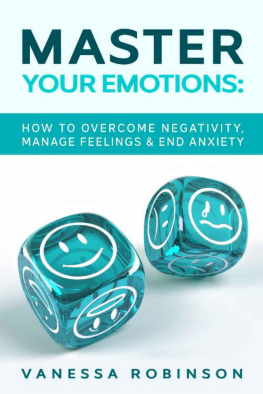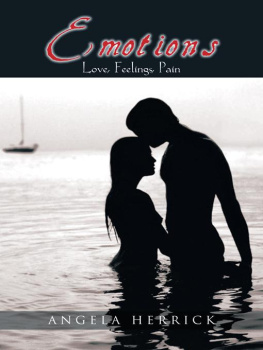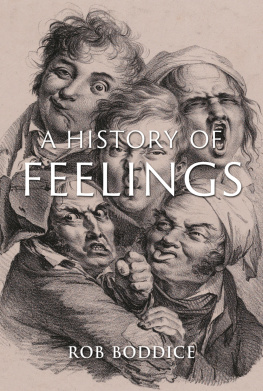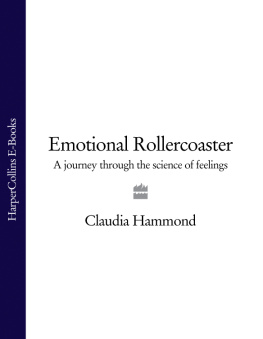THE BOOK OF HUMAN EMOTIONS
Tiffany Watt Smith is a research fellow at the Centre for the History of the Emotions, Queen Mary University of London, and was also a 2014 BBC New Generation Thinker. Before beginning her academic career she worked as a theatre director, including as an Associate Director at the Arcola Theatre and International Associate at the Royal Court. She lives in London.
WELLCOME COLLECTION is the free visitor destination for the incurably curious. It explores the connections between medicine, life and art in the past, present and future. Wellcome Collection is part of the Wellcome Trust, a global charitable foundation dedicated to improving health by supporting bright minds in science, the humanities and social sciences, and public engagement.
THE BOOK OF
HUMAN
EMOTIONS
An Encyclopedia of Feeling from Anger to Wanderlust
TIFFANY WATT SMITH

First published in Great Britain in 2015 by
PROFILE BOOKS LTD
3 Holford Yard, Bevin Way
London WC1X 9HD
www.profilebooks.com
Published in association with
Wellcome Collection

183 Euston Road
London NW1 2BE
www.wellcomecollection.org
Copyright Tiffany Watt Smith, 2015
The moral right of the author has been asserted.
All rights reserved. Without limiting the rights under copyright reserved above, no part of this publication may be reproduced, stored or introduced into a retrieval system, or transmitted, in any form or by any means (electronic, mechanical, photocopying, recording or otherwise), without the prior written permission of both the copyright owner and the publisher of this book.
A CIP catalogue record for this book is available from the British Library.
eISBN 978 184765 967 5
And how delightful other peoples emotions were!
much more delightful than their ideas, it seemed to him.
Oscar Wilde, The Picture of Dorian Gray
To my family with love, always
Introduction
Look up. Look up at the clouds. Are they grey and solemn in a windless sky? Or wisps floating carelessly on a breeze? Is the horizon drenched in a hot red sunset, angry with desire?
To the painter John Constable, the sky was full of emotion. He called it, in a letter written in 1821, the key note and chief organ of sentiment in painting. It is for this reason that he dedicated much of his time to collecting and classifying the clouds. Walking out from his house in Hampstead at that time a village near London with a bundle of papers, and a pocket full of brushes, he would sit for hours on the heath rapidly painting the changing shapes above him, the wind rustling his papers, rain drops pooling the colours. Once home, he arranged his sketches according to the latest meteorological classifications, noting the date, time and weather conditions.
Constable wanted to master the language of the sky and when you look at his paintings, its clear that he did. But he also lived in an age obsessed with the desire to label and put into categories, a passion for taxonomy that would always sit uneasily with the melting, drifting skies. Clouds are so hard to fix. Arranging them into groups, as the art critic John Ruskin discovered forty years later, was always a matter more of convenience than true description. The clouds fold into one another and drift away. They switch allegiances until its hard to tell them apart.
Look at the clouds, and you might see an emotion colour everything for an instant but then the skies will rearrange themselves and itll be gone.
Recognising and naming our emotional weather can be just as peculiar a task. Try to describe exactly how you feel right now. Is your heart fluttering excitedly for the person wholl be waiting when you step off the train? Or your stomach tight at the thought of tomorrows deadline? Perhaps it was curiosity which nudged you towards this book. Or reluctance, studded with giddy defiance, that is making you linger over its pages in the shop rather than returning home. Are you feeling hopeful? Surprised? (Are you bored?)
Some emotions really do wash the world in a single colour, like the terror felt as the car skids, or the euphoria of falling in love. Others, like clouds, are harder to grasp. Plan a surprise for a loved one and you might feel anticipation crinkled with glee and creased at the edges with a faint terror what if they hate it? Storm off during an argument and it might be hard to tell the precise moment at which your indignation ends and your clammy self-loathing begins. There are some emotions which are so quiet that they slip past before weve even had a chance to spot them, like that momentary sense of comfort which makes your hand reach out for a familiar brand at the supermarket. And then there are those that brood on the horizon, the ones we hurry away from, fearing they will burst upon us: the jealousy which makes our fingers itch to search a loved ones pockets, or the shame that can goad us into self-destruction.
Sometimes it feels more like we belong to our emotions, than they to us.
But perhaps its only by paying attention to our feelings, by trying to capture them as Constable did the clouds, that we can truly understand ourselves.
What is an emotion?
Deep inside each of our temporal lobes is a tear-shaped structure called the amygdala. Neuroscientists call this the command centre of our emotions. It assesses stimuli from the outside world, deciding whether to avoid or approach. It triggers a clatter of responses, raising the heartbeat, instructing the glands to secrete hormones, contracting the limbs or making an eyelid twitch. Recall a sad story or look at a picture of your newborn baby while lying in a brain scanner and the amygdala will be one of the areas that will appear to light up on the resulting computer-generated image.
With their glowing tapestries of magenta and emerald, studies of the brain can be seductive. They can even seem like the final word on how and why we feel the way we do. But to think of our emotions purely as biochemical fireworks in the brain is, in the words of the writer Siri Hustvedt, rather like saying that Vermeers Girl Pouring Milk is a canvas with paint on it or that Alice herself is words on a page. These are facts, but they dont explain my subjective experience of either of them or what the two girls mean to me.
More than that, I think, approaching emotions as first and foremost biological facts misrepresents what an emotion actually is.
The invention of emotions
No one really felt emotions before about 1830. Instead, they felt other things passions, accidents of the soul, moral sentiments and explained them very differently from how we understand emotions today.
Some ancient Greeks believed a defiant rage was carried on an ill wind. Desert-dwelling early Christians thought boredom could be implanted in the soul by malignant demons. In the fifteenth and sixteenth centuries, passions were not exclusive to humans, but could work their strange effects on other bodies too, so that palm trees could fall in love and yearn for one another, and cats become melancholic. But alongside this intangible realm of souls and supernatural forces, doctors also developed a complex approach to understanding the bodys influence on the passions. Their insights were based on a theory of humoral medicine from the ancient Greek physician Hippocrates, which spread via the physicians of the medieval Islamic world, and flourished ultimately in the writings of the court doctors of the European Renaissance. The theory held that each person had a balance of four elemental substances in their bodies blood, yellow bile, black bile and phlegm. These humours were thought to shape personality and mood: those with more blood in their veins were quick tempered, but also brave, while a dominance of phlegm made one peaceful but lugubrious. Physicians believed strong passions disrupted this delicate ecosystem by moving heat around the body and rousing the humours in turn. Rage sent blood rushing from the heart to the limbs, readying a person to launch an attack. Once black bile was heated, by contrast, it sent poisonous vapours curling up to the brain and crowded it with terrifying visions. Traces of these ideas still linger: its why we speak of people being phlegmatic or in an ill-humour, or say their blood is boiling.
Next page
